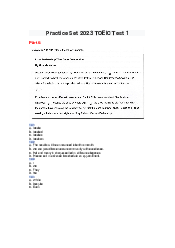














Preview text:
So sacred is the term “family” that it has been considered as an integral spiritual and physical shelter for
its kinfolks from their cradle to grave. However, an upsurge in generation gap has generated many more
conflicts among family members. In this essay, I would discuss several precursors to this issue before
some visible measures are drawn.
An increasing in the gap between generations could be attributed to several plausible reasons. A
prominent factor could be geographical distance. To illustrate, in some special cases, a certain family
member will have to work far away or the children will go to university in another city for a long time.
According to my case, as an official, my father has to work at an office located in another city and most
of his time spending on being the office, so this is the reason why I rarely meet him at our home to
confide in him about my normal life and it gets harder in the flow of time. It can be argued that
geographical distance could be the cause which prevents family from being as close as they used to be.
Topic 1: When choosing a job, the salary is the most important
consideration. To what extent do you agree or disagree?
People harbor different viewpoints with regard to the perception of whether
salary ponderation is a prioritized reason influencing on choosing a job. While I
believe that it is just one of the factors directly affecting on job selection of
someone, I also hold opinion that affordable salary can help the agency to
attract well-qualified employees and reduce the unemployment.
People harbor different viewpoints with regard to the perception of whether the world’s economies
would be influenced by international integration in a positive or negative way. While some people argue
that it would be better for the economy of the world, and I believe that global economies can reach
better places in the near future during international infiltration.
There is no denying that integrating into the globe could bring about tangible benefits for the followers
of this trend. The first obvious plus point could be that economy integration between countries, thereby
attracting investment from abroad to less developed nations. So the argument goes, once economy and
trade integration become easier within countries, it means that more and more opportunities for
employment would be created and also the chance for many countries to contract the investment from
overseas. However, I strongly believe it is irrefutable that potential downsides also persist as creating
waste or worker exploitation. As a result, globalization could be one of the reasons causing excessive
pollution and redundancies or job losses.
However, supporters of maintain that poverty could be reduced or human life could be improved within
the international integration. Albeit this argument seems to be a sensible reason given, it is my
perception that in the foundation of this society, many companies move to countries where human
labor is cheaper. It could be argued that they look to markets with cheap labor to reduce costs and
sometimes lay off their employees. In this way, it is more feasible and practical should local government
have reasonable policies to balance between increasing globalization and mitigating the negative
impacts caused by globalization.
The bar chart illustrates the data about the distribution of average weekly expense which families spent
for a whole year within the surveyed nation in 2 separate years 1968 and 2018.
Overall, what stands out from the graph is that people paid most of their percentage of weekly spending
for Food in 1968 than in 2018. Another striking point is that the families in 2018 had a tendency to
invest more proportion of weekly income in Leisure than that in 1968.
As can be seen in the first 4 four groups, the surveyed families in 1968 distributed by far the ratio of
weekly spending in Food which is twice as high as its in 2018. By contrast, the percentage of weekly
income spent on Housing by the surveyed families in 2018 was 19 per cent, nearly 2-fold as high as its in
1968. Furthermore, the families in 1968 allocated 6 percent and 10 per cent of weekly income on “Fuel
and power” and “Clothing and footwear”, respectively; compared with 4 per cent and 5 per cent of
weekly investing of its in 2018, respectively.
If we look at the 4 remaining groups, there was a gradual distribution in the proportion of weekly
income which distributed in both Household goods, Personal goods, Transport and Leisure by the
surveyed families in 1968, around 8 per cent and this figure for Household goods also recorded in the
families in 2018. In addition, the families in 2018 allocated 22 per cent and 14 per cent of the weekly
spending on Leisure and Transport, respectively while they just spent 4 percent of their weekly income on Personal goods.
The graph and bar chart indicate the data about the average amount of rainfall and the temperature
within one nation in East Africa, estimated in Millimeters and Celsius degree, respectively.
Overall, what stands out from the line graph is that there was a significant fluctuation in the
Temperature in the whole time. Another striking point is that the bar chart depicted a similar
distribution in the amount of rainfall with the temperature.th
If we look at the first four months of the line chart, the Temperature had a tendency to rise drastically
from 22.25 Celsius degree in January to reaching the peak of 23.5 Celsius degree, despite the slight
reduction in April. Notwithstanding a significant increase, Temperature saw by far a dramatic fall and
touched the bottom at 20.5 Celsius degree. In the last quarter of the surveyed year, the Temperature
was still low at 21.75 Celsius degree in December in spite of reaching the peak at 23.5 Celsius degree once again in October.
As can be seen in first quarter of the bar chart, the amount of rainfall in January was 20 Millimeters.
However, the figure for April saw by far a rocket growth at 275 Millimeters and this was a peak of the
rainfall in the whole time. By contrast, the amount of rainfall start decreasing significantly from the first
month of the next quarter up to the end of the period despite the jumping in the amount of the rainfall in October and November.
The bar chart depicts the data about the proportion of people who invest their money for charity
purposes in five different age profiles in Great Britain in 2 distinct years 1990 and 2010.
Overall, what stands out from the graph is that the British in the age brackets of 36-to-50 and 18-to-25
respectively had the most and the fewest percentage of partakers in comparison with others in 1990.
Another striking point is that the youngest age group also showed the lowest proportion of attendees
while the highest proportion belonged to the age of 51-to-65.
If we look at the first three age ranges, the 36-to-50 age bracket in 1990 had approximately 42 percent
of participants and this was also the highest figure while the teenager age profile (18-to-25) in 1990
accounted for the smallest rate (17 percent) over the surveyed time. Moreover, the 36-to-50 and 18-to-
25 age brackets in 2010 followed a relatively similar pattern in comparison with it in 1990, made up 35
percent and 7 percent respectively. Furthermore, the age bracket of 26-to-35 contributed at 31 percent in 1990 and 24 percent in2010.
Turning to the 2 remaining age profiles, nearly 40 percent of people donating money for charity went on
the 51-to-65 year olds in 2010 while in 1990 it just accounted for 35 percent. There was a similar figure
in the percentage of British people donating money between the age of over 65 in 2010 and the age of
51-to-65 in 1990. The figure for over 65 year olds in 1990 was 2.5 percent less than this in 2010, at around 32.5 percent.
People harbor different viewpoints with regard to the perception of whether spending working life for
only organization is better than different cooperations. While some argue that it would better for
workers or officers to work in a stable company for a long term, I believe that working for diverse
organizations can bring different experiences and opportunities to the workers.
As observed in the 1st stage portrayed, raw fresh fishes are processed before submerged in a mixture of
salt and water in a pot within 30 consecutive minutes. Afterward, the whole pot is put on the stove for
cooking the fishes in 5 minutes by heat. Then, the cooked fishes are taken out of the pot and gotten dry
naturally to prepare for the following stage.
In this stage, the dried fishes are passed through a smoking process in a wooden vat with an opened lid
above and a smoking contained in the bottom layer. Subsequently, after experiencing the smoking
process within half an hour, the fishes are injected with yellow coloring additive and packed with a
closed box before delivering to merchants.
The process illustrates the way of how to make a drinkable water from rain through a close sequences in
the specific town in Australia.
Overall, what stands out from the flowchart is that the procedure comprises 4 main steps, setting out
with getting rain from the roof and culminating in providing the clean water to the residents.
Upon the rainy season, each residence actively has rainfall collected on their roof top and then this
amount flows through into 3 separate drains to reduce the water pressure. Afterward, this amount of
water is passed through filtering system consisting of distinct filters listed as coal, soil… to eliminate the dirt. Livestock: gia súc
A herd of cattle: đàn gia cầm A school of fish: đàn cá
Status: địa vị , thứ hạng= position=ranking=hierarchy Chief: trưởng = main Prestige: uy tín
Bureaucracy = office: văn phòng Butcher: làm thịt cái j
At the following stage, after passing through the chipping machine, the chopped-up pieces experience
three distinct phases consisting of Mechanical pulping process, Chemical pulping process and Hydra
pulper. Then the mixture would be filtered impurities and clumps for cleaning and screening.
Subsequently, the pulp mixture is delivered to the making paper stage and resulting the sheets of paper
finally be manufactured by paper machine and stored in stock house in advance of shipping to retail agent.
The flowchart portrays how to generate concrete canvas in an open chain.
Overall, what stands out from the diagram is that the procedure consists of 8 main steps altogether,
commencing with producing the concrete canvas and culminating by forming the warehouse for storage.
At the first step in the process, the concrete canvas was generated by piling 3
distinct layers up on each others ranging from the fibrous substance on the top
surface, the dry concrete in the middle to bottom layer made with water-
resistant material. Afterwards, the concrete canvas is delivered to the workshop
before the cover is unwrapped out of the concrete cube by a worker. Then 2
tails of the canvas are fixed by the pegs and the remaining tails are tied with the
back of the lorry by a rope for stretching out the concrete canvas.
At the following stages, an air pumper is utilized to inflate to the maximum 8-meter-height.
Subsequently, the inflated concrete canvas is sprayed with the beam of water onto the
outer layer before letting it dry naturally from 20 to 24 hours and the resulting
stock house can finally be manufactured for further purposes.
EXERCISE 2: Identify the Type of Sentence
Identify whether the following sentences are simple, compound or complex
sentences. Also, mention which of the clauses is the main clause and the subordinate clause.
1. I did not know that this food was meant only for the staff.
2. She is innocent, so she has appealed to the court.
3. If you are not ready with the song, it is better to let them know.
4. She will come home or I will stay back at her place.
5. In the evening, I am going to the park.
6. The sun looks amazing today.
7. I remember the day that we met very well.
8. Nithi is not keeping well, yet she decided to go to work.
9. After they reach the hotel, they will inform us. 10. We are going to the park.
EXERCISE 3: Combine the following sentences using a coordinating conjunction
or a conjunctive adverb to form compound sentences.
1. My mother is sick. My mother is going to the doctor.
2. Jibin has gone to Hyderabad. Jibin has not found any jobs yet.
3. Nalini was not satisfied with her birthday dress. Nalini wore it anyway.
4. Jaffar called me yesterday. I was not able to attend his call.
5. Tina had to present the paper today. Nancy volunteered to do it.
6. It was raining the whole day. We decided to go to the park.
7. Firoz will pick you up. We will book a cab for you.
8. Nobody knew where to go. We asked some random people for directions to the hills.
9. Let them know. You will have to suffer the consequences.
10. My mom was cleaning the house. I helped with the plates.
EXERCISE 4 – COMBINE THE SENTENCES TO FORM COMPLEX SENTENCES
Combine the following sentences by making use of a subordinating conjunction
or a correlative conjunction to form complex sentences.
1. You speak up. Nobody is going to know.
2. You are the only friend. You taught me right from wrong.
3. I was not happy. I went to the reception for the sake of my friend.
4. You do not finish it. You will have to face the consequences.
5. I do not know the person. He owns a brand new Mercedes Benz.
6. My brother does not watch animation movies. My brother liked Kungfu Panda.
7. I don’t think I will be able to make it. I missed the bus.
8. You should do it. I will have to ask Praveen to do it.
9. There are no trains available. We took a flight.
10. Seetha finishes her work. Seetha will be on her way.
The horizontal bar chart portrays the allocations in four separate daily
productions consisting of milk, cheese, butter, and milk powder. These products
were manufactured by different countries within the year 2012, estimated in Metric tons.
Overall, what stands out from the chart is that EU was the top manufacturer in
Milk and Cheese sector, while the top producer in Butter and Milk powder
belonged to 2 Asia nations India and China, respectively. Another striking point
is that Milk production saw by far an impressive statistic amongst the 4 recorded products.
If we look at the data of Milk, EU witnessed a significant approximate 143k MT
and became the head country in this industry. This was followed by India with 127k MT
and US with around 90k MT. Glancing to Cheese, EU was in the majority of Cheese production in the
world with over 7000 MT, which is 10-fold higher than the figure for Brazil and 200 MT greater than US.
As observed in the statistic of Butter, India became the dominant in this sector with 7500 MT, which
is quadruple than EU and over 9-fold higher than the US. Turning to Milk powder, China and New
Zealand generally saw a similar figure in the production of Milk powder ranging from 1100 MT to
1200 MT while the data for EU was just 770 MT.




